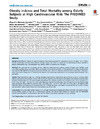Please use this identifier to cite or link to this item:
https://accedacris.ulpgc.es/jspui/handle/10553/21072
| Title: | Obesity indexes and total mortality among elderly subjects at high cardiovascular risk: The PREDIMED study | Authors: | Martínez-González, Miguel Ángel García-Arellano, Ana Toledo, Estefanía Bes-Rastrollo, Maira Bulló, Mónica Corella, Dolores Fitó, Montserrat Ros, Emilio Lamuela-Raventós, Rosa María Rekondo, Javier Gómez-Gracia, Enrique Fiol, Miquel Santos-Lozano, Jose Manuel Serra-Majem, Lluis Martínez, J. Alfredo Eguaras, Sonia Sáez-Tormo, Guillermo Pintó, Xavier Estruch, Ramón |
UNESCO Clasification: | 3206 Ciencias de la nutrición | Keywords: | Obesity Mortality Elderly Caridovascular risk factor PREDIMED study |
Issue Date: | 2014 | Journal: | PLoS ONE | Abstract: | Background: Different indexes of regional adiposity have been proposed for identifying persons at higher risk of death. Studies specifically assessing these indexes in large cohorts are scarce. It would also be interesting to know whether a dietary intervention may counterbalance the adverse effects of adiposity on mortality. Methods: We assessed the association of four different anthropometric indexes (waist-to-height ratio (WHtR), waist circumference (WC), body mass index (BMI) and height) with all-cause mortality in 7447 participants at high cardiovascular risk from the PREDIMED trial. Forty three percent of them were men (55 to 80 years) and 57% were women (60 to 80 years). All of them were initially free of cardiovascular disease. The recruitment took place in 11 recruiting centers between 2003 and 2009. Results: After adjusting for age, sex, smoking, diabetes, hypertension, intervention group, family history of coronary heart disease, and leisure-time physical activity, WC and WHtR were found to be directly associated with a higher mortality after 4.8 years median follow-up. The multivariable-adjusted HRs for mortality of WHtR (cut-off points: 0.60, 0.65, 0.70) were 1.02 (0.78-1.34), 1.30 (0.97-1.75) and 1.55 (1.06-2.26). When we used WC (cut-off points: 100, 105 and 110 cm), the multivariable adjusted Hazard Ratios (HRs) for mortality were 1.18 (0.88-1.59), 1.02 (0.74-1.41) and 1.57 (1.19-2.08). In all analyses, BMI exhibited weaker associations with mortality than WC or WHtR. The direct association between WHtR and overall mortality was consistent within each of the three intervention arms of the trial. Conclusions: Our study adds further support to a stronger association of abdominal obesity than BMI with total mortality among elderly subjects at high risk of cardiovascular disease. We did not find evidence to support that the PREDIMED intervention was able to counterbalance the harmful effects of increased adiposity on total mortality. Trial Registration: Controlled-Trials. com ISRCTN35739639 | URI: | https://accedacris.ulpgc.es/handle/10553/21072 | ISSN: | 1932-6203 | DOI: | 10.1371/journal.pone.0103246 | Source: | PLoS ONE [EISSN 1932-6203], v. 9 (7), e103246, (Julio 2014) | Rights: | by-nc-nd |
| Appears in Collections: | Artículos |
SCOPUSTM
Citations
27
checked on Jun 8, 2025
WEB OF SCIENCETM
Citations
22
checked on Jun 8, 2025
Page view(s)
110
checked on Jul 13, 2024
Download(s)
134
checked on Jul 13, 2024
Google ScholarTM
Check
Altmetric
Share
Export metadata
Items in accedaCRIS are protected by copyright, with all rights reserved, unless otherwise indicated.
